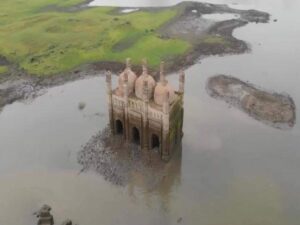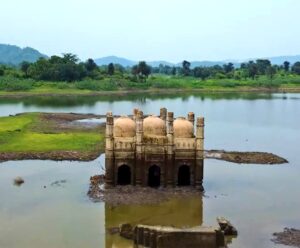According to Kashmir Media Service, a mosque that was submerged thirty years ago has reemerged due to drought-related changes in the Phulwaria Dam’s water in the Nawada district of the Indian state of Bihar.
Following the drying up of water near the southern end of the dam reservoir, a submerged mosque in Chiraila hamlet of the Rajauli block has been discovered. The mosque was known as Noori Masjid, and it was flooded in 1985 during the construction of the Phulwaria Dam. The mosque rises around 30 feet from the ground to the highest dome. According to the report, the construction of the mosque sparked curiosity among the locals, and a large number of young people were spotted swarming the area when they saw the mosque.
They were quite shocked to discover a mosque there because they had always seen the water area in the reservoir. A large group of young people was observed rushing towards the mosque while trudging through the mud and snow to reach the historic building’s parapet. Many people entered the mosque and were shocked to see that it was in perfect condition. The mosque’s ability to remain structurally intact while being buried for many years was its most interesting feature. When the water level used to drop before, only a portion of the mosque’s dome was visible, making it difficult for people to understand what it was for. Now that they can see the mosque in the open and the ground is entirely dry, their interest has subsided.

This submerged mosque has a history dating back to before the construction of the Phulwaria Dam got underway in 1979. Even when the dam’s construction was finished, the mosque remained unaltered. The mosque and the entire area were entirely drowned by the dam’s water reservoir. According to many, this mosque was constructed somewhere in the early 20th century and is, at most, 120 years old. After examining the mosque’s dome’s construction, which is noticeably sharper and an improvement above domes constructed during the later Mughal era, this conclusion was reached.

Considering that August 15 is the deadline for planting paddy, India’s Jharkhand state may be categorized as being in a drought after that date, according to agriculture minister Badal Patralekh, who recently stated as much in the Jharkhand Assembly. 56 reservoirs in the state, except a few, are seeing a dropping water level with only 40% of their capacity full, an official said on Saturday. This is due to a lack of rainfall across Jharkhand. According to state Water Resource Department Chief Engineer (monitoring) Motilal Singh, if the monsoon rains continue to be illusive, this could cause a drinking water crisis in the months to come and worsen water supply to agricultural fields for irrigation.


